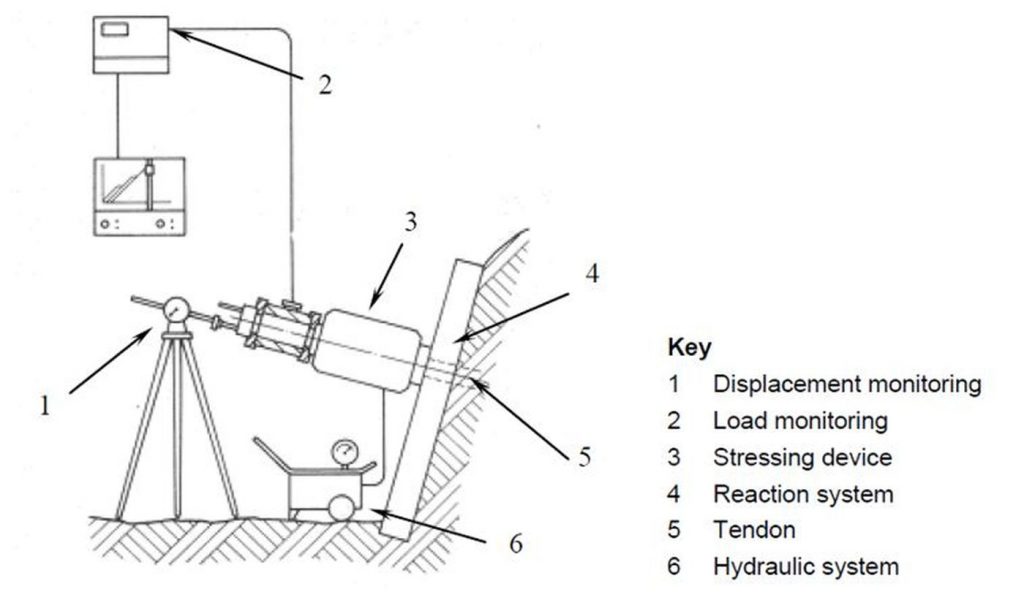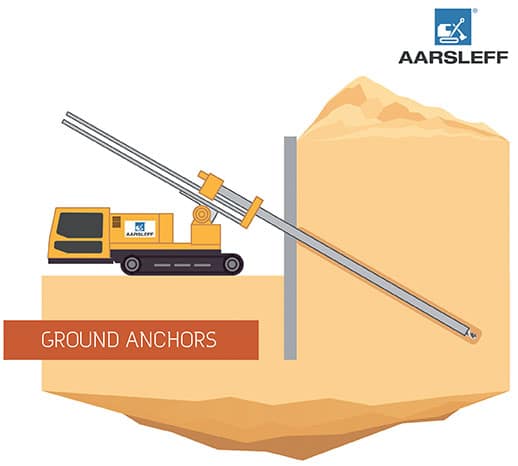Just How Sturdy Earth Anchors Job: A Comprehensive Guide to Dirt Anchoring Solutions
Sturdy Earth supports play a vital duty in supplying security and support in numerous building and construction applications. By embedding deeply into the ground, they withstand upright and side pressures properly. Different kinds of anchors accommodate different soil problems, making them flexible. Recognizing their auto mechanics and setup strategies is essential for maximizing efficiency. What aspects influence their effectiveness, and just how do they compare to traditional methods? The solutions may surprise you.
Comprehending Heavy-Duty Earth Anchors
Heavy-duty Earth anchors act as important parts in numerous construction and landscaping projects, providing stability and support in challenging dirt problems. These supports operate by being embedded right into the ground, where they stand up to vertical and lateral pressures. Their layout enables protected attachment to frameworks, ensuring they remain anchored versus dirt movement or exterior loads.The performance of durable Earth supports largely depends upon the sort of dirt and the anchor's installation depth. Correct setup strategies are crucial, as they establish the support's holding capacity. Ecological factors, such as wetness and freeze-thaw cycles, can also affect performance.These anchors are regularly made use of in applications ranging from safeguarding fencings and keeping walls to supporting momentary frameworks during negative weather. Recognizing the principles behind sturdy Earth anchors is vital for professionals seeking to boost the resilience and safety and security of their tasks.
Types of Heavy-Duty Earth Anchors
Various kinds of sturdy Earth supports are created to meet particular requirements based upon dirt problems and project requirements. Helical anchors, featuring screw-like blades, are efficient in softer dirts, supplying high load abilities and simple setup. Driven anchors, which are hammered into the ground, appropriate for rocky terrains and provide prompt lots support. Tie-back supports are generally utilized in maintaining wall surface applications, permitting lateral support by securing right into the ground at an angle. An additional kind is the cast-in-place support, ideal for concrete applications, as they are incorporated right into structures for improved stability. Finally, soil screw supports are flexible alternatives that can be utilized in numerous dirt types, providing trustworthy stress and compression capacities. Each kind offers unique applications, guaranteeing stability and security in building and construction and landscape design projects. Comprehending these options permits notified choices in choosing the ideal Earth securing solution.
The Mechanics of Soil Anchoring

Recognizing the auto mechanics of dirt anchoring needs an evaluation of various sorts of Earth supports and their installation techniques. Each anchor kind provides distinct qualities that affect its performance in different dirt conditions. Correct installation techniques are necessary for maximizing the securing system's stability and performance.
Kinds of Earth Anchors
Earth anchors, essential components in dirt anchoring systems, come in numerous kinds, each designed for certain applications and soil conditions. One of the most typical types include screw anchors, which are twisted right into the ground, supplying strong side resistance. Helical anchors feature blades that allow for effective installation in numerous soil kinds, making them suitable for both short-term and permanent applications. Driven anchors, normally made from steel, are hammered right into the dirt and are effective in thick or rough environments. Auger anchors make use of a helical style to assist in installation in softer soils. Ultimately, plate anchors contain a flat plate hidden flat, distributing lots over a larger location, perfect for applications needing high tons capabilities in cohesive dirts.
Installation Strategies Clarified
Appropriate installation techniques are vital for the effectiveness of soil anchoring systems. The procedure typically starts with site assessment, validating the chosen location can support the support's lots. After determining the correct support type, proper hole depth and angle need to be developed. The installation involves driving the support into the ground using customized devices, such as hydraulic or hand-operated chauffeurs, to accomplish ideal embedment. Post-installation, tensioning the anchor is important to assure security; this is often confirmed with lots testing. Furthermore, surrounding dirt conditions ought to be kept track of to stop variation. Adhering to these methods not only improves the anchor's performance however additionally prolongs its life expectancy, giving trusted assistance for different applications.
Applications of Heavy-Duty Earth Anchors
While sturdy Earth anchors are often connected with building and construction and landscape design, their versatility extends to a variety of applications throughout different markets. In civil engineering, they supply vital support for preserving wall surfaces, guaranteeing security in locations vulnerable to dirt disintegration. The aquatic field uses these supports for protecting anchors and marinas, protecting against motion brought on by tides and currents. Furthermore, in the telecommunications market, durable Earth anchors are substantial for stabilizing cell towers and other high structures versus wind pressures. Agricultural applications additionally benefit, as these anchors can protect structures like greenhouses and livestock secure fencing, ensuring they withstand severe weather. Moreover, in renewable power tasks, such as wind ranches, Earth supports play an important role in protecting turbine foundations, improving total security and efficiency. This wide series of applications highlights the versatility and dependability of sturdy Earth anchors throughout various fields.
Benefits Over Typical Anchoring Methods
Although typical anchoring techniques have actually long been trusted for stability, sturdy Earth supports offer considerable benefits that boost efficiency and performance. One significant advantage is their remarkable load-bearing ability, which allows them to endure higher pressures without failing. This strength makes them suitable for demanding applications, such as in building and construction and energy installations.Additionally, sturdy Earth supports are made for deeper installation, giving greater stability in various soil problems, including loose or sandy soils. Their resistance to corrosion and environmental variables guarantees a longer lifespan and minimized maintenance costs contrasted to standard methods.Moreover, these supports can be mounted with marginal disruption to the surrounding area, protecting the honesty of the landscape. Generally, sturdy Earth anchors provide a effective and trusted linked here service for securing requirements, going beyond the restrictions typically connected with standard anchoring methods.
Installment Refine and Best Practices
The installment process for dirt securing remedies starts with complete prep work and site analysis to assure peak efficiency. Following this, a step-by-step installation overview supplies clear directions for effective execution (tensile load anchors). Sticking to these ideal methods is crucial for achieving trustworthy and long-lasting anchoring outcomes
Prep Work and Website Analysis
Efficient prep work and thorough website examination are vital action in the setup of dirt anchoring services. Prior to setup, the dirt kind need to be assessed to identify its bearing ability and viability for anchoring. Conducting a geotechnical survey can provide crucial info regarding dirt structure, dampness degrees, and prospective ground movement. In addition, identifying existing structures, plant life, and energies is vital to stay clear of interference during installation. The area needs to be free from debris and challenges to ensure safe gain access to for equipment. Climate condition must likewise be monitored, as adverse conditions can affect both security and installment effectiveness. By diligently preparing the website and examining all pertinent elements, the chance of successful support efficiency is substantially increased.
Step-by-Step Installment Overview
A complete installation process is vital for attaining optimal efficiency of soil anchoring services. The setup begins with selecting the suitable support kind and guaranteeing the site is free from particles. Next off, correct hole positioning is determined based on load demands. Once the location is established, holes are drilled to the defined deepness and size utilizing the appropriate tools. The anchor is after that inserted into the opening, making certain it is aligned appropriately. After protecting the anchor, soil is backfilled and compressed to improve security. It is important to follow producer standards throughout the procedure. A post-installation examination validates that the supports are sufficiently positioned and functioning as meant, offering reputable assistance for the desired application.

Maintenance and Inspection of Earth Anchors
Normal maintenance and inspection of Earth anchors are vital for ensuring long-term efficiency and security. Regular checks permit the early discovery of issues such as deterioration, loosening up, or dirt motion. Inspectors need to seek indications of rust or deterioration on the support parts, particularly at the link factors. Furthermore, the bordering soil should be examined for erosion or changes in wetness material, which can impact anchor effectiveness.It is advisable to establish a regular evaluation routine, preferably at the very least once a year, depending on ecological problems. Throughout examinations, all visible elements ought to be cleansed to remove dirt or particles that can hide possible problems. Any indications of distress, such as tilting frameworks or uncommon settling, ought to motivate immediate examination. Appropriate documents of evaluations can aid in monitoring anchor performance gradually and facilitate timely maintenance actions, guaranteeing the supports stay trusted and useful.
Frequently Asked Concerns
What Materials Are Heavy-Duty Earth Anchors Usually Made From?
Heavy-duty Earth anchors are normally constructed from durable products such as galvanized steel or stainless steel, making sure stamina and resistance to deterioration. These materials provide long-lasting support and stability in various dirt problems and applications.
Exactly How Do Soil Problems Impact Anchor Efficiency?
Soil conditions significantly affect support efficiency. Variables such as dirt type, dampness web content, and compaction impact the support's grasp and stability, with natural dirts often providing better resistance than loosened or sandy soils, affecting overall performance.
Can Heavy-Duty Earth Anchors Be Reused After Elimination?
Durable Earth supports can be recycled after elimination, supplied they are checked for damages and wear. Appropriate cleansing and upkeep improve their longevity, ensuring efficient efficiency in succeeding installations when problems allow for secure reinstallation.
What Are the Environmental Effects of Using Earth Anchors?
The environmental impacts of utilizing Earth supports consist of possible soil disturbance, interruption of regional ecosystems, and feasible contamination of groundwater. Nonetheless, if used responsibly, their benefits typically outweigh these problems, advertising security in numerous applications.
Just how Do I Choose the Right Support for My Project?

Comments on “Everything You Didn’t Know About soil anchoring solutions in Infrastructure Projects”